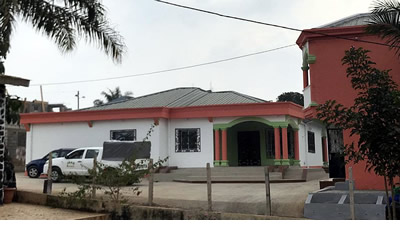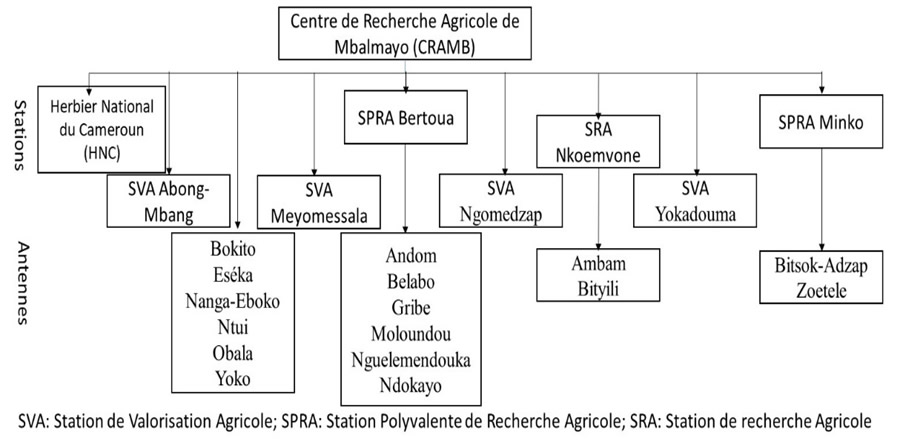 The Mbalmayo Agricultural Research Centre (CRAMB) replaces the former Regional Agricultural Research Centre of Nkolbisson (CRRANK). The CRAMB covers the dense forest agroecological zone with bimodal rainfall, namely the Central, Southern and Eastern regions. This stems from the organizational chart of the Board of Directors meeting of 04 September 2020.
The Mbalmayo Agricultural Research Centre (CRAMB) replaces the former Regional Agricultural Research Centre of Nkolbisson (CRRANK). The CRAMB covers the dense forest agroecological zone with bimodal rainfall, namely the Central, Southern and Eastern regions. This stems from the organizational chart of the Board of Directors meeting of 04 September 2020.
Missions of the Centre
CRAMB is responsible for conducting research on stimulating plants, fruit and fruit trees, annual crops, forests, production systems, environmental protection, product processing and agricultural mechanisation.
It must also provide answers to the constraints linked to peri-urban agriculture and livestock.
To coordinate and lead CRAMB's activities, the Head of the Centre is assisted by a Head of the Scientific Support Unit (CAS) and a Head of the Administrative and Financial Affairs Department (SAAF). At the head of each of the structure's branches, there is a Branch Head.Operational Structures

CRAMB's key activities
Annual crops
On cassava:
- Collection, identification of local varieties and inventory of diseases and pests;
- Setting up a nursery for several cassava accessions;
- Establishment of different propagation fields for cuttings (Ntui, Mbalmayo, Meyomessala).

On rice:
- Development of intensive rice cultivation techniques (new fertiliser rates) and integration of rice cultivation into local cropping systems;
- Introduction of rainfed upland rice production in the Central Region (Nkolbisson, Nkol-Koumou and Zamengoe).
Perennial crops
On cocoa trees:
- Development of hybrid cocoa varieties ;
- Knowledge of the influence of shading on the spatial distribution of mirids in cocoa farms
- Reduction of the number of phytosanitary treatments against brown pod rot
- Development of effective and sustainable integrated pest management methods.
- Characterisation of the economic structure of farms based on FAS-cocoa
- Determination of the food security level of cocoa farm households
- Identification of alternative host trees for cocoa mirids
- Development of an indirect method of chemical control of mirids: the root drench
Capacity building of cocoa farmers through exposure to endogenous pest and disease control strategies and prevention of the introduction of new phytosanitary constraints.
On fruit trees:
- Diagnosis of citrus decline and identification of associated factors in cocoa-based agroforestry systems;
- Development of integrated control methods against citrus diseases (cercosporiose, gommose)
- Highlighting the important role of fruit trees in family farms (FFS);
- Establishment and maintenance of avocado and citrus woodlots
Forests and the environment:
- Development of the cutting technique in a plastic cutting container of Okok (Gnetum spp.), njangsang (Ricinodendronheudelottii), wild mango and Bitter cola leafy plants (preferably taken from young individuals);
- Development of domestication and vegetative propagation techniques (layering, grafting, cuttings) for about 30 trees of social and economic importance.
Animal and fish production
- Development of feed formulations (monogastric) based on agricultural and industrial by-products;
- Development of feed technologies and formulations for fish farming in ponds;
- Development of semi-floating feed production techniques for fish nutrition;
- Development of biological control techniques in ponds using toad protectors for fish.
Post-harvest technologies:
- Development of the technique for the production of juice from rice, ginger;
- Development of rice flour production technique;
- Development of the technique for the production of Pop Rice;
- Preparation of rice cookies;
- Production of 100% Arabica ground coffee.
List of available data sheets
- Annual crops
- Data sheet for maize seed production ;
- Data sheet for cassava seed production;
- Data sheet for rice seed production;
- Data sheet for the production of certified rainfed rice seed;
- Data sheet for certified lowland rice seed production;
- Construction of improved silos to increase maize storage time and reduce post-harvest losses quantitatively and qualitatively;
- Perennial crops
- Data sheet on cocoa pod multiplication ;
- Data sheet on the production of cocoa plants;
- Papaya Solo (Caricapapaya L.) and cultivation practices.
- Animal and fish production
- Fry production data sheet ;
- Data sheet on broiler feeding;
- Broiler production data sheet;
- Data sheet on pig rearing;
- Production systems, economics and rural sociologies
- Data sheet on making juice from rice and ginger ;
- Data sheet on the production of rice flour;
- Data sheet on the manufacture of Pop Rice;
- Data sheet on making rice cookies.
